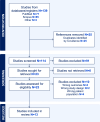Neck circumference as a metabolic health marker among women with polycystic ovary syndrome (PCOS): a systematic review and meta-analysis
- PMID: 40259008
- PMCID: PMC12158769
- DOI: 10.1038/s41366-025-01753-1
Neck circumference as a metabolic health marker among women with polycystic ovary syndrome (PCOS): a systematic review and meta-analysis
Abstract
Background: Polycystic ovary syndrome (PCOS) is associated with obesity, insulin resistance (IR), metabolic syndrome (MetS), and abnormal fat distribution, especially fat excess in the upper body. Neck circumference (NC) reflects the adiposity accumulation in the upper body and may be a valuable and simple screening tool for metabolic risk among women with PCOS.
Methods: A systematic review was conducted using PubMed/Medline and Scopus based on the search terms "neck circumference" and "PCOS". Studies that examined associations of NC and anthropometric measurements, blood pressure (BP), lipid values, glucose metabolism, MetS, IR, or related disorders among women with PCOS were included. A meta-analysis was performed to compare NC values between women with PCOS and non-PCOS controls.
Results: Of 139 publications, 13 full texts that met the selection criteria were included in the systematic review. Eight studies had non-PCOS controls and were thus eligible for the meta-analysis. Women with PCOS had significantly larger NC compared to non-PCOS controls (SMD: 0.78, 95% CI: 0.31-1.25, p = 0.0012). We found a positive association between larger NC and higher waist circumference, hip circumference, triglycerides, systolic BP, fasting insulin, and HOMA-IR or lower HOMA%S and higher prevalence of MetS or IR in the majority of the included studies. Neck circumference cut-off values for MetS varied from 33 cm to 34.25 cm and for IR 34.25 cm up to 42 cm among women with PCOS. Most of the studies were done with Asian populations thus limiting applicability of the study results to other ethnicities.
Conclusions: This meta-analysis demonstrated increased NC among women with PCOS compared to healthy controls. Women with PCOS and larger NC were more insulin resistant and had more MetS-related abnormalities when compared to women with smaller NC with or without PCOS. Data considering NC cut-off values for MetS and IR among women with PCOS are scarce, and further studies are needed, particularly among more varied ethnic populations.
© 2025. The Author(s).
Conflict of interest statement
Competing interests: The authors declare no competing interests. Ethics approval and consent to participate: An ethics statement or informed consent of the study participants was not applicable as the study bases exclusively on already published literature. All included studies except for one [34] included an ethical statement. In addition, all included studies reported that an informed consent was collected from the study participants with the exception of one study [36].
Figures
Similar articles
-
Comparative effects of acupuncture and metformin on insulin sensitivity in women with polycystic ovary syndrome: a systematic review and meta-analysis.Front Endocrinol (Lausanne). 2025 Jun 18;16:1553684. doi: 10.3389/fendo.2025.1553684. eCollection 2025. Front Endocrinol (Lausanne). 2025. PMID: 40607225 Free PMC article.
-
High prevalence of moderate and severe depressive and anxiety symptoms in polycystic ovary syndrome: a systematic review and meta-analysis.Hum Reprod. 2017 May 1;32(5):1075-1091. doi: 10.1093/humrep/dex044. Hum Reprod. 2017. PMID: 28333286
-
The Effects of Supplementation with Chromium on Insulin Resistance Indices in Women with Polycystic Ovarian Syndrome: A Systematic Review and Meta-Analysis of Randomized Clinical Trials.Horm Metab Res. 2018 Mar;50(3):193-200. doi: 10.1055/s-0044-101835. Epub 2018 Mar 9. Horm Metab Res. 2018. PMID: 29523006
-
Insulin-sensitising drugs (metformin, rosiglitazone, pioglitazone, D-chiro-inositol) for women with polycystic ovary syndrome, oligo amenorrhoea and subfertility.Cochrane Database Syst Rev. 2017 Nov 29;11(11):CD003053. doi: 10.1002/14651858.CD003053.pub6. Cochrane Database Syst Rev. 2017. PMID: 29183107 Free PMC article.
-
Alterations of insulin sensitivity, clearance, and secretion, either alone or in combination, in women with PCOS: impact on metabolic profile and androgenemia.Hum Reprod. 2025 Aug 1;40(8):1550-1561. doi: 10.1093/humrep/deaf114. Hum Reprod. 2025. PMID: 40514041
References
-
- Lizneva D, Suturina L, Walker W, Brakta S, Gavrilova-Jordan L, Azziz R. Criteria, prevalence, and phenotypes of polycystic ovary syndrome. Fertil Steril. 2016;106:6–15. - PubMed
-
- Teede H, Tay CT, Laven J, Dokras A, Moran L, Piltonen T, et al. International evidence-based guideline for the assessment and management of polycystic ovary syndrome 2023. Monash University, Melbourne, Australia, 2023. 10.26180/24003834.v1.
-
- DeUgarte CM, Bartolucci AA, Azziz R. Prevalence of insulin resistance in the polycystic ovary syndrome using the homeostasis model assessment. Fertil Steril. 2005;83:1454–60. - PubMed
-
- Lim SS, Davies MJ, Norman RJ, Moran LJ. Overweight, obesity and central obesity in women with polycystic ovary syndrome: a systematic review and meta-analysis. Hum Reprod Update. 2012;18:618–37. - PubMed
-
- Legro RS, Kunselman AR, Dodson WC, Dunaif A. Prevalence and predictors of risk for type 2 diabetes mellitus and impaired glucose tolerance in polycystic ovary syndrome: a prospective, controlled study in 254 affected women. J Clin Endocrinol Metab. 1999;84:165–9. - PubMed
Publication types
MeSH terms
Substances
LinkOut - more resources
Full Text Sources
Medical
Miscellaneous



